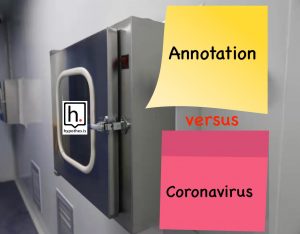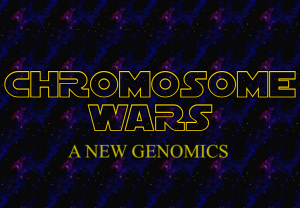Things to do when stuck at home because of the Coronavirus: Get Annotating
 Stuck indoors and bored of passively reading information on the coronavirus (and more) when you could be doing something more constructive? GigaScience now has hypothes.is integration for collaborative annotation, and we would encourage readers to interact with our content more collaboratively. Here we outline eight things we do to add value to papers with such hypothes.is integration.
Stuck indoors and bored of passively reading information on the coronavirus (and more) when you could be doing something more constructive? GigaScience now has hypothes.is integration for collaborative annotation, and we would encourage readers to interact with our content more collaboratively. Here we outline eight things we do to add value to papers with such hypothes.is integration.
With the international lockdown caused by the coronavirus pandemic meaning that a large proportion of the global researcher community are out of the lab and working from home, there are lots of things they are still able to do to keep themselves busy.
Our editors have noticed a boost in our submissions in recent weeks as researchers get on top of their long put off paper writing, and catching up on reading the literature is another likely beneficiary of the lack of conference travel and lab time. The coronavirus crisis has been described as an “infodemic”, and there has never been a more important time for the open and rapid dissemination of research data to tackle the information gaps and debunk the misinformation surrounding this crisis. The entire world is discussing competing modelling studies from Imperial College and Oxford University, and the US President tweeting about papers in the International Journal of Antimicrobial Agents, there has never been as much public awareness and interest in the scientific literature. The preprint servers have done an excellent job increasing the speed of communication surrounding this work, but there has been some controversy over the screening process and whether the general public can understand that this work isn’t peer reviewed. The peer reviewed literature has struggled too in balancing rapid dissemination and correcting errors and misinformation.
With this firehose of information and everyone becoming armchair epidemiologists, more than ever we need mechanisms to filter through the hysteria and bad science. We need to discover the good information and filter out the bad so that society and policy makers can make properly informed decisions about our health. Better navigating this complex world of networked digital communications. One means to do this is through collaborative annotation of online content, so we don’t just passively consume information and can actively connect. Which will enrich and contribute to our own experiences and views. Tim Berners-Lee included annotation as a basic capability in his first description of what would become the World Wide Web in 1989. Annotation has become a WC3 web standard, and one excellent tool enabling this is hypothes.is. Through creating contextual relationships between ideas & content across the Internet, these approaches have been used for crowdsourced fact-checking, flagging online misinformation, and publicly bridge it to refuting evidence & professional fact-checking services (see CrowdFact).
In 2015 we joined the “Annotating All Knowledge” coalition that promotes these efforts, and integrated the open source hypothes.is tool in our GigaDB repository to allow annotation to our datasets. We also experimented with annotation competitions to help increase hypothes.is and iClickval annotations on our datasets, setting up an Annotometer to track who contributed the most annotations. There are several different ways that individuals can use hypothes.is. You can install the Chrome extension or bookmarklets for other browsers so that you can activate hypothes.is whenever you want. Normally users would have to login to see public annotations, but following the successful integration by eLife, our publishers OUP have now integrated journal level annotation on our journal platform. This integration is quite discreet, but you may have noticed on the top right corner of our papers a little eye symbol to toggle highlight visibility. Or coloured highlighted text on any specific annotations on our papers that are viewable without logging in (but if you want to contribute annotations you need to have an account and add annotations to our curated GigaScience Annotations group).
Now you know how it works we’d encourage you all to get annotating. To give you some examples of the types of things that can be done, here are eight examples of things we’ve been doing to add value to our papers with hypothes.is integration.
1.Connect coronavirus related content
Many hypothes.is users are tagging coronavirus related content with the hypothes.is tag COVID-19, making it a useful information stream for curated information on the topic. While we haven’t published any COVID-19 papers yet, we have posted blogs on the topic, as well as many relevant papers in the area of viral genomics. As we are Open Access by default all our content is discoverable and accessible to all, but 30 major publishers have made their closed access content relating to coronavirus research available for free via various portals. Our publisher OUP has made one such portal, and some relevant GigaScience papers have had their visibility highlighted there, which is another mechanism to promote relevant content. We’ve highlighted these papers in hypothes.is and would encourage others to tag relevant content here.
2. Updating education resources
With educators having to take their teaching online, collaborative annotation can also facilitate and assist with these expanded online classes. And the majority of activity on the hypothes.is has been happening in education, with more than 12,000 teachers at over 600 schools making reading visible, active & social with the tool. Journals can help facilitate this with online teaching resources like Science in the Classroom (see video), and this can be expanded to medical education, as medical guides can quickly become out of date. With drugs constantly approved or withdrawn, and changes in regulations meaning annotation can keep these resources timely.
3. Updating review articles
At GigaScience we like to publish Review articles covering the state-of-the-art of important, data-heavy research areas, but what is defined as the state-of-the-art can quickly change in these technology driven fields. In 2014 we published a Review on the advances in genome editing technology, and as a particularly fast paced area of research we were worried that the supplemental table covering online tools for TALEN and CRISPR would very rapidly become out of date, so we included a GitHub wiki to enable this to be updated in an editable manner. Now we have integrated annotation this makes updating this kind of content even easier.
4. Assisting translation of abstracts or key parts of articles into other languages
Like disease outbreaks, science crosses borders, and another barrier we need to break down in open science is the language barrier. Lessons learned fighting COVID-19 in Wuhan or Bergamo are crucial to translate and pass on to the new front lines of the outbreak in New York and London. Our editor Hongling Zhao provided a nice example translating a crucial part of a paper to make it understandable for Chinese readers.
5. Updating data and software in papers
We initially started working with hypothes.is as a way of updating our datasets in GigaDB, but we can also use it to add similar details directly into the paper. Both providing easy links to access data and other information that is connected to the paper, highlighting things in-situ that might be difficult to spot in the references and supplemental files. And also providing links to information that may be missing at the time of publication, for example adding updated processed or other related datasets that might not have been available in time for publication. The same goes for software, where new versions may be released after publication and the paper annotated to highlight these advancements and updates.
6. Generating discussion on topical areas
 We and other journals have not found much benefit from public commenting functionality, and our papers no longer have commenting features at the bottom of the page. Filling this gap hypothes.is allows this type of commenting to feature more prominently and directly visible at the key points in the paper, so we are much happier to let this replace commenting at the bottom of the paper. As we publish opinion papers as Commentaries, these often welcome feedback to stimulate discussion on important issues in our “large-scale” data scope. For example we recently published a proposal to reconcile the nomenclature and vocabularies in cytology and genomics, trying to avoid conflict with the historical definitions of the terms chromosome and karyotype. As a contentious topic in genomics we encouraged readers to annotate their comments and provide input using hypothes.is as well as by using the hashtag #chromosomenomenclature. Another advantage of hypothes.is is you can set up other reader groups and private as well as public layers, allowing collaborators being able to generate ongoing virtual discussions directly on papers.
We and other journals have not found much benefit from public commenting functionality, and our papers no longer have commenting features at the bottom of the page. Filling this gap hypothes.is allows this type of commenting to feature more prominently and directly visible at the key points in the paper, so we are much happier to let this replace commenting at the bottom of the paper. As we publish opinion papers as Commentaries, these often welcome feedback to stimulate discussion on important issues in our “large-scale” data scope. For example we recently published a proposal to reconcile the nomenclature and vocabularies in cytology and genomics, trying to avoid conflict with the historical definitions of the terms chromosome and karyotype. As a contentious topic in genomics we encouraged readers to annotate their comments and provide input using hypothes.is as well as by using the hashtag #chromosomenomenclature. Another advantage of hypothes.is is you can set up other reader groups and private as well as public layers, allowing collaborators being able to generate ongoing virtual discussions directly on papers.
7. Highlighting pre- and post- publication peer review
At GigaScience we mandate open, signed peer review, and this pre-publication history is visible in the supplemental files and also automatically hosted via citable DOIs in publons. But it may be easy to miss this for the casual reader, and these reviews can be made more visible through hypothes.is annotations. Post-publication review can also continue through blogs and forums (virological.org being a great venue for COVID-19 related work), F1000 reviews, Stack Exchange Q&As, and many other means, all of which can be highlighted on our papers using this hypothes.is integration.
8. Enrich papers with news, video and other content
GigaScience have from launch been keen to move papers beyond static-PDFs, and hypothes.is helps enrich papers with associated news articles, topical contextual information, and multimedia. Allowing people to keep connected to information related to the paper. Our Assemblathon2 paper was a good example of this, with over 20 blogs and news features written about the article, and we’ve highlighted this through annotation. There are many other things that can be added to enrich papers, and we’ve used hypothes.is integration to link related videos (.e.g. video abstracts) and audio content (e.g. podcasts) to articles.